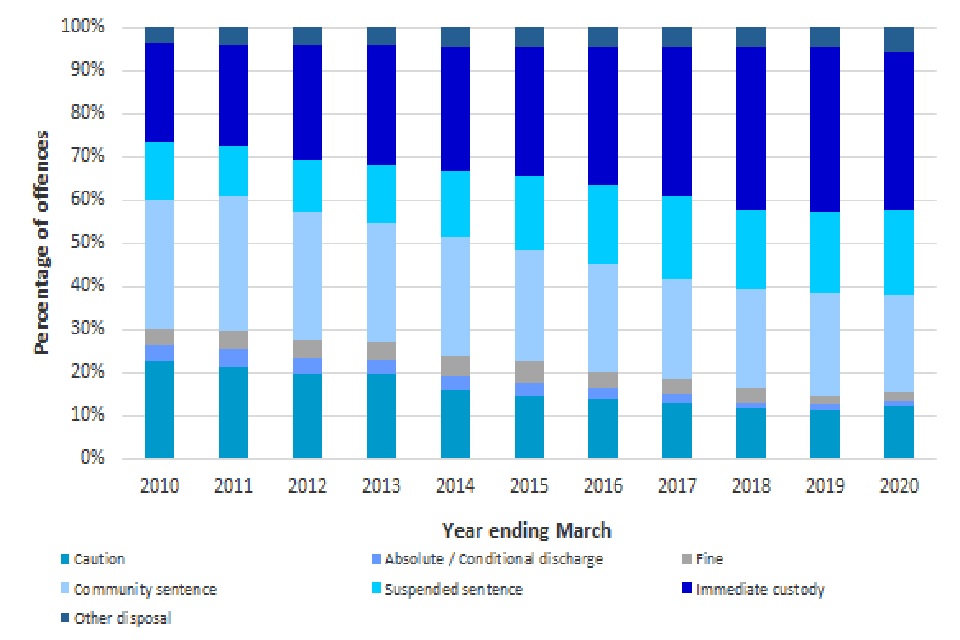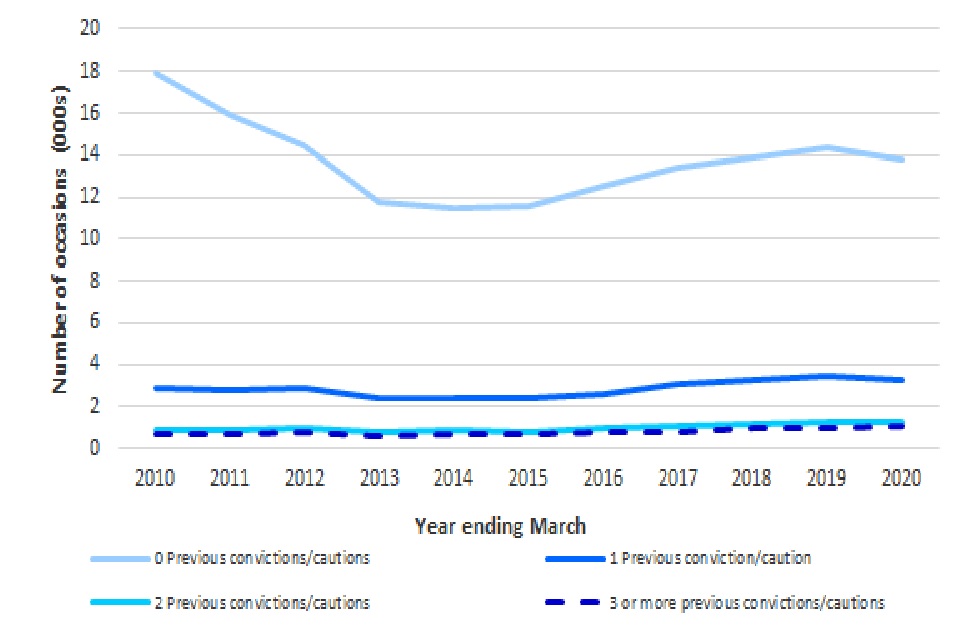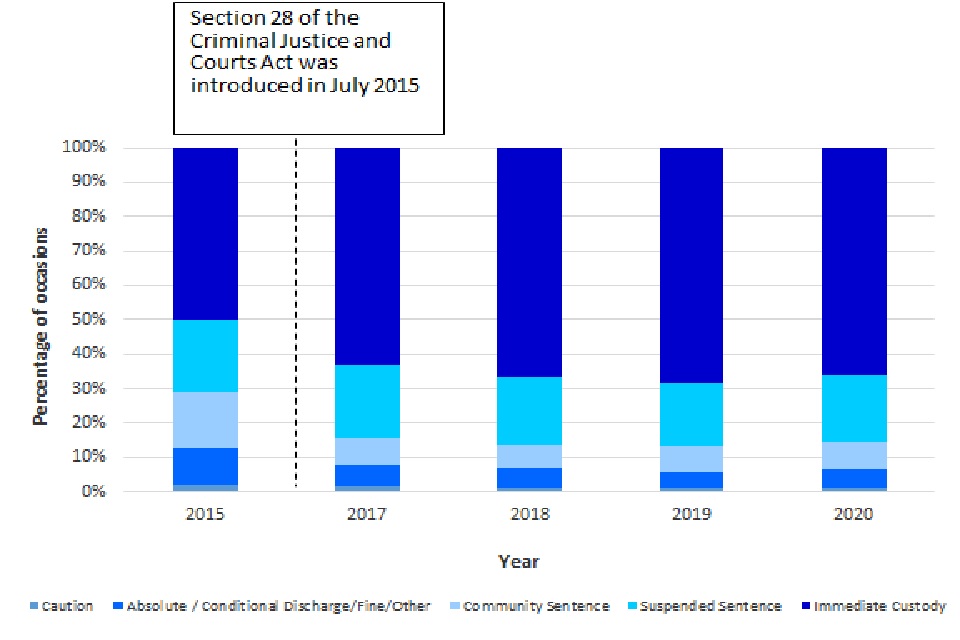Knife and offensive weapon sentencing statistics: year ending March 2020
Trends in cautioning and sentencing of knife and offensive weapon offences.
Documents
Details
Contents
2. Knife and offensive weapon offences overview
5. Sentencing under section 28 of the Criminal Justice and Courts Act (CJCA) 2015
7. Future publications and contact details for any queries or feedback
This publication presents key statistics describing the trends in the number of offenders receiving cautions and convictions for
-
possession of an article with a blade or point
-
possession of an offensive weapon, or
-
threatening with either type of weapon
in England and Wales. It should be noted that figures for the latest year have been estimated and should be treated as provisional. Please refer to the technical guide for further details.
Accompanying files
As well as this bulletin, the following products are published as part of this release:
-
ODS format tables containing data on knife or offensive weapon offences up to March 2020
-
An interactive table tool to look at previous offences involving possession of a blade, point or offensive weapon. The tool provides further breakdowns by gender, police identified ethnicity and prosecuting police force area. The data used in the tool is also included as a separate csv file.
-
An interactive Sankey diagram looking at outcomes for offenders sentenced for these offences by whether or not they have a previous conviction or caution for possession of a blade, point or offensive weapon; which includes breakdowns by gender, age group and offence type.
Main points
| Point | Change | Commentary |
|---|---|---|
| The number of knife and offensive weapon offences dealt with by the Criminal Justice System (CJS) had been increasing since 2014 but stabilised in the latest year. | Decrease | In year ending March 2020 21,498 knife and offensive weapon offences were formally dealt with by the CJS, a decrease of 3% since year ending March 2019. This comes after a rise of 35% from 16,431 in year ending March 2014 to 22,124 year ending March 2019. |
| The proportion of offenders receiving an immediate custodial sentence for a knife and offensive weapon offence has remained stable for the last three years at around 38%. | Increase | Between year ending March 2010 and year ending March 2017 there was an increase in the proportion of offenders receiving an immediate custodial sentence for a knife and offensive weapon offence, from 23% to 35%, but the trend has been broadly stable at 38% over the last three years. The average length of the custodial sentences received increased from 6.5 months in year ending March 2010 to 8.1 months in year ending March 2020. |
| For just under three quarters (71%) of offenders this was their first knife or offensive weapon possession offence. | Decrease | The proportion of offenders for whom this is their first knife or offensive weapon possession offence has been decreasing over the last decade, from 80% in the year ending March 2010 to 71% in the year ending March 2020. |
| The average custodial sentence received by offenders sentenced under section 28 of the Criminal Justice and Courts Act 2015 was 7.9 months in year ending March 2020. | Increase | This has risen since year ending March 2017, the first full year after the legislation was established, where it was 7.1 months. |
1. Statistician’s comment
The number of knife and offensive weapon offences dealt with by the Criminal Justice System (CJS) has been increasing since 2014, but figures for the latest year show that these are now stabilising, with a slight decrease in the year ending March 2020. The latest figures cover the period to the end of March 2020 and any COVID-19 impacts, are likely to be small. Further information about COVID-19 impacts on courts can be found in the HMCTS regular management information publication.
Sentencing in this area has remained stable over the last three years, with around 38% of offenders receiving an immediate custodial sentence for a knife and offensive weapon offence. The average custodial sentence length has been increasing from 6.5 months over the last decade and is now currently just over 8 months in the year ending March 2020.
The proportion of offenders for whom this is their first knife or offensive weapon possession offence has been decreasing over the last decade, from 80% in the year ending March 2010 to 71% in the year ending March 2020. This trend is visible for both adults and juveniles.
2. Knife and offensive weapon offences overview
The number of knife and offensive weapon offences dealt with by the Criminal Justice System (CJS) has been increasing since 2014 but has stabilised in the latest year.
Figure 1: Knife and offensive weapon offences by offence type, England and Wales, annually from year ending March 2010 (Source: Table 1a)

In year ending March 2020 21,498 knife and offensive weapon offences were formally dealt with by the CJS, a decrease of 3% since year ending March 2019. This comes after a rise of 35% from 16,431 in year ending March 2014 to 22,124 year ending March 2019. Figure 1 shows that the previous increase is driven by possession of an article with a blade or point offences, which increased to 14,012 offences in year ending March 2019. The fall over the latest year has been driven by a 6% fall in the number of possession of offensive weapon offences from 7,222 in year ending March 2019 to 6,790 in year ending March 2020.
The number of adult offenders convicted or cautioned for a knife or offensive weapon offence has decreased by 3% in the last year while the number of juveniles convicted or cautioned decreased by 1%.
Recent police recorded crime figures published by the ONS showed a 2% increase in the number of knife and offensive weapon offences recorded from 35,146 in year ending March 2019 to 35,815 in the year ending March 2020. This continues the increase seen since year ending March 2013 but is the smallest increase since then. Furthermore, information published by the Home Office on “Crime outcomes in England and Wales” show that 50% of these offences resulted in a charge or police caution in the year ending March 2020.
3. Sentencing
The proportion of offenders receiving an immediate custodial sentence for a knife and offensive weapon offence has remained stable for the last three years at around 38%.
Figure 2: Knife and offensive weapon offences by disposal type, England and Wales, annually from year ending March 2010 (Source: Table 1)

The proportion of offenders receiving immediate custodial sentences has remained stable at around 38% for the last three years, but has increased since year ending March 2010 when 23% received immediate custodial sentences. In year ending March 2020 nearly 8,000 knife and offensive weapon offences dealt with resulted in immediate custody compared with around 5,400 in year ending March 2010. This increase has been driven by adults, for whom there was a 49% increase in offenders receiving immediate custody in the period.
The increase in average custodial sentence length between year ending March 2010 and year ending March 2020 was seen in all age groups and offence types but particularly for adults, for whom it increased from 6.5 months to 8.2 months, and for possession of blade or point offences, where it increased from 5.6 months to 7.4 months.
4. Offending History
For 71% of offenders this was their first knife or offensive weapon possession offence
The proportion of offenders for whom this is their first knife or offensive weapon possession offence has been decreasing over the last decade, from 80% in the year ending March 2010 to 71% in the year ending March 2020.
The decrease in the proportion of first time knife and offensive weapon offenders has been seen for both adults and juveniles, with the proportion for adults decreasing from 77% to 68% between year ending March 2010 and year ending March 2020 and the proportion for juveniles decreasing from 91% to 83% over the same period.
Figure 3: Number of previous cautions or convictions for the possession of a knife or offensive weapon offence for offenders cautioned or convicted for a knife or offensive weapon offence, England and Wales, annually from year ending March 2010 (Source:Interactive Pivot Table Tool)

Figure 3 shows that whilst the proportion of first time offenders for this offence type has fallen the number of offenders dealt with for their first knife and offensive weapons offence has remained broadly stable over the last three years.
While the proportion of offenders dealt with who had one or more previous knife and offensive weapons possession offences has increased year on year, rising from 20% in year ending March 2010 to 29% in year ending March 2020, the numbers of such offenders have fluctuated.
5. Sentencing under section 28 of the Criminal Justice and Courts Act (CJCA) 2015
Following the commencement of section 28 of the CJCA 2015, a court must impose a minimum custodial sentence on an offender who has been convicted of a second or subsequent offence involving possession of a knife or offensive weapon. The court must impose the minimum sentence unless it would not be in the interest of justice to do so.
The average custodial sentence received by offenders sentenced under section 28 of the Criminal Justice and Courts Act 2015 was 7.9 months in year ending March 2020.
This has risen since year ending March 2017, the first full year after the legislation was established, where it was 7.1 months. Over the same time period the average custodial sentence length has increased from 7.2 to 8.0 months for adults and 5.9 to 7.2 months for 16 and 17 year olds.
Figure 4: Knife and offensive weapons possession sentencing and cautioning occasions for adult repeat offenders, by disposal type, year ending March 2015 and annually from year ending March 2017 (Source: Interactive Pivot Table Tool and Table 7)

In year ending March 2015, prior to the introduction of this legislation, half (50%) of adult knife and offensive weapons possession offenders with at least one previous knife and offensive weapons possession offence received an immediate custodial sentence. In year ending March 2020 two thirds (66%) of adult offenders sentenced under section 28 of the CJCA 2015 received an immediate custodial sentence. Overall 85% of adult offenders sentenced under section 28 of the Criminal Justice and Courts Act 2015 in year ending March 2020 received some form of custodial sentence, either immediate custody or a suspended sentence, compared to 71% of adult offenders with at least one previous knife and offensive weapons offence in year ending March 2015.
For 16 and 17 year olds, in year ending March 2020 42% of offenders sentenced under section 28 of the CJCA 2015 received an immediate custodial sentence compared to 28% of knife and offensive weapons possession offenders with at least one previous knife and offensive weapons possession offence in year ending March 2014.
6. Further information
The data presented in this publication are provisional and updated in each publication. Figures provided for more recent quarters are subject to change in future publications as ongoing cases pass through the Criminal Justice System.
A technical guide provides further information on how the data is collected and processed, as well as information on the revisions policy and legislation relevant to knife and offensive weapon sentencing.
Official Statistics status
Official statistics are produced under the remit of the Code of Practice for Official Statistics. They are produced impartially and are free from political influence. More information can be found on the UK Statistics Authority website
7. Future publications
Next update: 10 December 2020
Our statisticians regularly review the content of publications. Development of new and improved statistical outputs is usually dependent on reallocating existing resources. As part of our continual review and prioritisation, we welcome user feedback on existing outputs including content, breadth, frequency and methodology. Please send any comments you have on this publication including suggestions for further developments or changes in content.
Contact
Press enquiries should be directed to the Ministry of Justice press office:
Tel: 020 3334 3536
Email: [email protected]
Other enquiries about, or feedback on, these statistics should be directed to the Justice Statistics Analytical Services division of the Ministry of Justice:
Chandni Lakhani,
Ministry of Justice,
102 Petty France,
London,
SW1H 9AJ
Email: [email protected]
© Crown copyright Produced by the Ministry of Justice. Alternative formats are available on request from [email protected]
8. Pre-release access
The bulletin was produced and handled by the ministry’s analytical professionals and production staff. Prior to publication pre-release access of up to 24 hours was granted to the following persons:
Ministry of Justice:
Lord Chancellor and Secretary of State for Justice; Parliamentary Under Secretary of State – covering youth justice; Parliamentary Under Secretary of State – covering sentencing; Permanent Secretary; Minister and Permanent Secretary Private Secretaries (9); Special Advisors (2); Deputy Director for Bail, Sentencing and Release Policy; Head of Custodial Sentencing Policy Unit; Senior Policy Advisor, Custodial Sentencing Policy Unit; Head of Courts & Sentencing, Youth Justice Policy; Policy Advisor, Youth Sentencing; Head of News and relevant press officers (4).
Youth Justice Board:
Data Analyst, YJB Information and Analysis.
Home Office:
Home Secretary; Parliamentary Under Secretary of State for Safeguarding; Parliamentary Under Secretary of State for Crime, Policing and the Fire Service; Minister Private Secretaries (4); Special Advisor; Assistant Private Secretary to the Special Advisors; Head of Serious Violence Unit; Policy Advisor, Serious Violence Unit; Statistician, Violent Crime; and relevant press officers (2).
Cabinet Office:
Private Secretary to the Prime Minister; Principal Analyst, Prime Minister’s Implementation Unit.